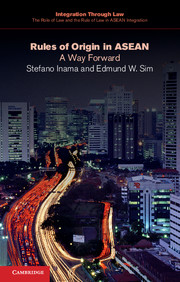Book contents
- Frontmatter
- Contents
- List of Tables
- General Editors’ preface
- Preface
- List of Abbreviations
- Chapter 1 Introduction
- Chapter 2 The initial set of ASEAN rules of origin: the lack of clarity and transparency masquerading as simplicity 1992–1995
- Chapter 3 Externalizing the confusion: the proliferation of rules in the ASEAN FTAs with dialogue partners
- Chapter 4 The silent cost: the cumbersome administration of ASEAN rules of origin
- Chapter 5 The possible way forward: self-certification
- Chapter 6 Conclusion and recommendations
- Executive Summary
- Appendices
- Bibliography
- Index
Chapter 5 - The possible way forward: self-certification
Published online by Cambridge University Press: 05 March 2015
- Frontmatter
- Contents
- List of Tables
- General Editors’ preface
- Preface
- List of Abbreviations
- Chapter 1 Introduction
- Chapter 2 The initial set of ASEAN rules of origin: the lack of clarity and transparency masquerading as simplicity 1992–1995
- Chapter 3 Externalizing the confusion: the proliferation of rules in the ASEAN FTAs with dialogue partners
- Chapter 4 The silent cost: the cumbersome administration of ASEAN rules of origin
- Chapter 5 The possible way forward: self-certification
- Chapter 6 Conclusion and recommendations
- Executive Summary
- Appendices
- Bibliography
- Index
Summary
The Form D process thus involves an emphasis on the verification of paper documentation, rather than the verification of the underlying facts of the transaction. ASEAN government authorities devote more time and resources to confirming whether the Form D document conforms to the ATIGA requirements than to whether the goods actually qualify for the duty preferences.
Self-certification by exporters would move the focus away from the Form D documentation and toward the fundamentals of the transaction. Under certain conditions, trusted traders/exporters could provide a statement/declaration about the origin of the product in question on the invoice. While maintaining a substantial degree of reliability, it would be simpler and more cost-effective and would therefore enhance utilization of the advantages offered by the ATIGA.
Self-certification is based on the assumption that “the exporter knows best” what it is making, how it is made and who supplied the materials to make it; in other words, the exporter is – almost – always in the best position to initially establish whether its goods satisfy the applicable origin criteria. Frankly, the Form D process is also based on the same principle: it is the exporter that declares in the application for a CO that its goods meet the applicable RoO.
- Type
- Chapter
- Information
- Rules of Origin in ASEANA Way Forward, pp. 76 - 85Publisher: Cambridge University PressPrint publication year: 2015



